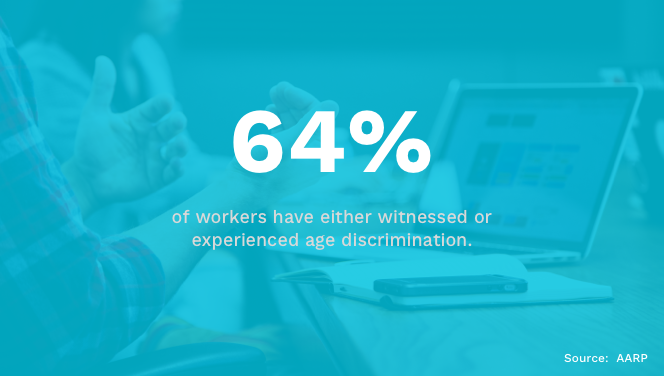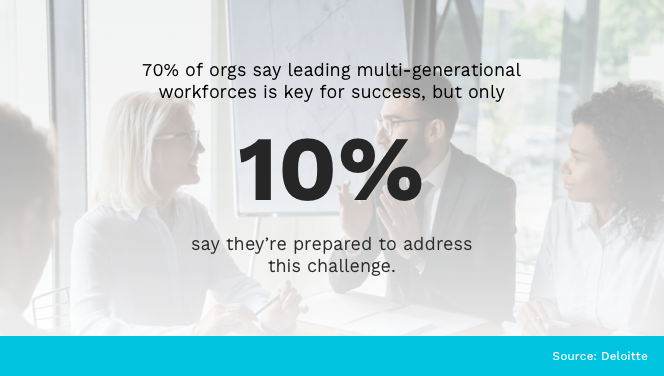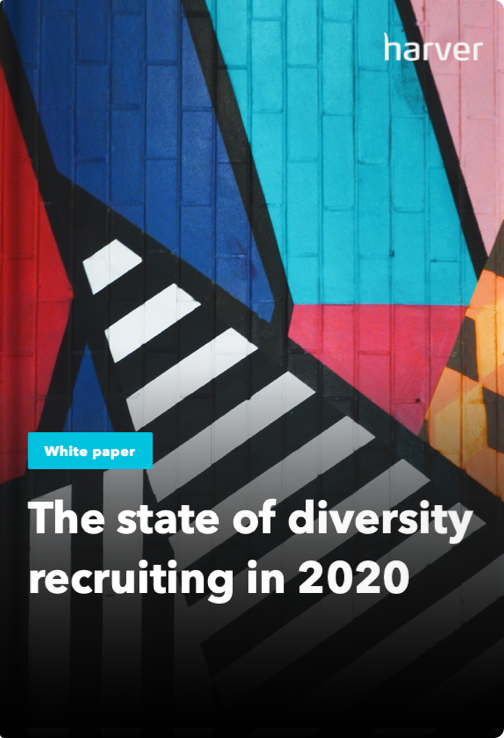Today, most organizations prioritize having a diverse workforce because of the numerous benefits it brings to their company. Managing age and generational diversity should be a robust part of any D&I strategy.
Age has been one of the ‘protected characteristics’ in the workplace since 1967, when the Age Discrimination Employment Act (ADEA) was passed. This means that employers in the US are not allowed to discriminate against their employees based on their specific age or generation.
While the law clearly outlines what is and isn’t allowed, 53 years later, companies are still struggling to adhere to the mandate. A study by AARP found that 64% of workers have either witnessed or experienced age discrimination.
While ageism is predominantly reported by older workers, it can cut both ways. What does ageism look like? It could be telling the 28 year old she’s too young for a managerial position, or it could be telling the 50 year old candidate that you’re looking for a college graduate with no bad habits and a long career ahead of them.
If you’re leading a multigenerational workforce, how can you successfully attract, hire and retain the different generations?
What’s in?
Like what you see?
Don’t miss out. Subscribe to our quarterly digest to get the latest TA and TM resources delivered right to your inbox.
1. Avoid stereotyping
Our brains, in order to save time tend to automatically lean on stereotypes to make faster decisions. We need to actively look out for these short-cuts and challenge biased thinking when it happens.
While it’s good to consider generational differences in the workplace when attracting, hiring, engaging and retaining your employees, you should avoid relying on stereotypes. If an employee has been working for you for many years, it doesn’t mean you can assume they don’t want to continue to grow and learn, that they’re ready to slow down and retire.
You never know what a different phase of life makes someone capable of:
- Samuel L. Jackson hit his stride until he was 46.
- Morgan Freeman got his big break at 52.
- Henry Ford was 45 when he created the Model T car.
- Harry Bernstein was 96 when he got his first book published.
What can you do to avoid stereotyping in the workplace?
- Commit to fight stereotyping in the first place.
- Realize that the older workforce is a wealth of knowledge.
- Invest in employee development including training to recognize bias.
- Believe that everyone is an individual.
2. Beware of ageism
With 64% of employees having borne witness to ageism, or experienced it themselves, perhaps now is the time to remind employees what ageism looks like so every employee can be alert to it, to watch out for the signs of it and know how what options are available, should it occur.
Ageism in a multigenerational workforce isn’t just negative stereotypes towards older employees/candidates, it can also include:
- Only offering learning opportunities to younger employees.
- Not giving certain age groups the more challenging work assignments.
- Not including everyone at client meetings or leaving them out of company events.
- Only viewing those with young children at home as having legitimate family commitments.
- Making remarks about someone’s age or joking about their fitness levels, or making pointed comments that they should step aside and let someone younger have a go.
- Passing people over for promotion based on their age, rather than their performance.

3. Implement inclusive recruitment strategies
If you’re wanting to attract a multigenerational workforce, for starters, you need to write inclusive job posts. Some things to consider include:
- If you want people who don’t fit your status quo to apply to the job, don’t make them feel excluded. That means writing job descriptions without jargon and ageism embedded within them. Instead, focus on clearly defining the job role and the skills and competencies it requires. Ask someone outside of your organization to proofread it and make sure it is easily understood.
- Widen your search to include the pools of talent you’re trying to tap into. Think about where you’re placing your advert. Ask the job boards you’re using to promote your openings about their audience. If they aren’t the right audience, switch job boards.
- Design an inclusive application process. Ensure all messaging throughout the application process is friendly and welcoming, simple and easy to understand. Does your equality and diversity policy stand out?
- Educate your team on unconscious bias and make sure they’re fairly shortlisting candidates. If in doubt, have a diverse panel shortlist applicants so they can challenge any bias that might arise. Read CVs with the personal data covered up.
- Conduct inclusive interviews with a diverse interview panel. Prepare questions and scoring systems beforehand so that every candidate is treated equally.
4. Rethink your employee benefits and perks
Most organizations employ up to four different generations – Baby Boomers, Gen X, Millennials, and Gen Z. Every one of these generations have a different mindset from the others, with different aspirations, different needs and wants, and even different values.
While Millennials will make up 75% of the workforce come 2025, that doesn’t mean that you should only tailor your benefits and perks to them. The UK Office for National Statistics revealed that 71% of people plan on working long after they reach retirement age (65 in the UK).
Managing a multigenerational workforce means offering employee benefits that cater to all, including both the employees you’d like to attract and those you want to retain. Don’t assume that everyone needs the same benefits and perks. In a multigenerational workplace, adopting a one size fits all policy won’t work.
For example ditch the office ping pong table and beer fridge in favour of:
- Flexible or agile working. It isn’t just parents of young children who appreciate flexible working. Aging employees who have parents to care for need flexible working options too.
- Health and wellbeing initiatives. From health insurance plans to life insurance, gym membership to healthy snacks in the workplace, even discounted mindfulness programs and mental health support including access to Employee Assistance Programs (EAP) will be appreciated across the board.
- Retirement savings options. It’s never too early, or late, to consider retirement planning. Offering a 401(k) package with employer matching can be incredibly attractive, no matter an employee’s age.
- Reward long service. Encourage employees to stick around by offering a paid two month sabbatical after a set period of employment, i.e. 5 years. Six months after ten years.
- Assistance with debt. For Millennials, help with paying off their student loan is a great perk, for Gen Z, it can be a deal breaker. With student loans debt in the US standing at $1.67 trillion as of October 2020, getting ahead while being burdened with debt can make life for younger workers difficult.
Do your research on what benefits are most sought after for your employees and consider the option of customizing your benefits packages to meet different generational needs. If funding the benefits and perks is a struggle for you, offer tiered benefits packages tied to different grades at your company instead.
The state of diversity recruiting in 2020
5. Tailor your employer branding strategy
Building a multigenerational workforce will give your company a powerful competitive advantage. So how do you attract each generation with their different motivations and drivers?
The only way to effectively target each generation is by having a clear understanding of who each one is and how they differ. Try and refrain from generalizing candidates in each category, remember everyone is an individual. Instead, use the individual generational cohorts to guide your employer branding strategy.
- Refine the ways and channels you use to communicate your brand.
- Understand what motivates and attracts each generation and what these generations have in common.
- Focus on communicating your values to attract workers who can identify with them.
- Make sure your brand ethos and values permeate every aspect of your recruitment strategy. From the job posting itself to onboarding the successful candidate, be consistent in your messaging and what you do.
Essentially, your employer branding should be an honest reflection of what employees can expect if they join your organization, no matter which generation you’re trying to attract.
6. Build a culture of learning and collaboration
One of the major benefits of a multigenerational workforce is the breadth of knowledge and experience. You need to work on creating a culture where these are shared and where employees are encouraged to learn from each other.
Just think what could be achieved if you encouraged all of your employees to believe that everyone else has something to teach them. Forward thinking companies have harnessed the power of multigenerational teams by:
- Organizing lunch & learn sessions.
- Hosting training sessions where each employee teaches others something new.
- Partnering up older employees with younger employees, it could be mutual mentoring or job shadowing. Educate employees that younger generations aren’t naive and older generations aren’t outdated – that both have much to learn from the other.

7. Monitor employee engagement and employee experience
Keeping on top of employee engagement, employee experience (EX) and satisfaction for every member of your workforce is important now more than ever. With the vast majority of employees currently working from home, keeping coworkers feeling connected is a big part of it.
Keep on top of EX via surveys or qualitative interviews. Based on the results, you can prepare strategies to improve on engagement and EX.
8. Manage workplace expectations
When hiring new employees, you should manage their workplace expectations throughout the hiring and onboarding process.
For example, make sure that everyone:
- Is aware of your flexibility options.
- Knows that work-life balance for all employees is important.
- Has access to, and is encouraged to undertake career development and ongoing education.
- Know your preferred means of communicating with colleagues – each generation has their preferred means of communicating, i.e. Gen Y send texts, Baby Boomers make phone calls. Encourage each team member to get to know one another and communicate via their preferred method.
- Is aware of how formal or informal the work environment is.
The more you can manage expectations prior to starting work, the easier new employees will find their early days with you.
9. Review your company policies
Check whether your company policies are inclusive and mindful of your multigenerational workforce. If they’re not, now is the time to update them.
For example, your policies around pension and retirement plans, your policies around caretaker leave, or employee development. Make sure that everything you have in place is inclusive.
Conclusion
Leading a multigenerational workforce needs to be done thoughtfully if you want it to be successful. Having an inclusive, collaborative culture and focusing your efforts on improving every employee’s experience at your organization helps you make sure that you’re providing everyone with what they need to thrive.
The state of diversity recruiting in 2020


